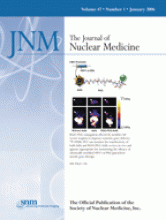Abstract
Tumor-induced angiogenesis can be targeted by RGD (Arg-Gly-Asp) peptides, which bind to αvβ3-receptors upregulated on angiogenic endothelial cells. RGD-containing peptides are capable of inducing apoptosis through direct activation of procaspase-3 to caspase-3 in cells. Additionally, tumor cells overexpressing somatostatin receptors can be targeted by somatostatin analogs. Radiolabeled somatostatin analogs are successfully used to image and treat such tumors via receptor-targeted scintigraphy and therapy. We combined these 2 peptides, RGD and somatostatin, to synthesize a new hybrid peptide, RGD-diethylenetriaminepentaacetic acid (DTPA)-octreotate (c(Arg-Gly-Asp-d-Tyr-Asp)-Lys(DTPA)-d-Phe-c(Cys-Tyr-d-Trp-Lys-Thr-Cys)-Thr). An earlier study showed that tumor-bearing rats had high receptor-specific uptake of RGD-111In-DTPA-octreotate in somatostatin receptor subtype 2–positive tissues and tumors. Furthermore, RGD-111In-DTPA-octreotate showed a pronounced tumoricidal effect, which is probably the result of increased apoptosis, as is shown by an increased caspase-3 activity after incubation with 111In-labeled RGD-DTPA-octreotate in comparison with the 2 monopeptides 111In-DTPA-RGD and 111In-DTPA-Tyr3-octreotate. In this study, we evaluated the biodistributions of RGD-111In-DTPA-octreotate and 125I-RGD-octreotate and investigated the caspase-3 activation of the unlabeled compound RGD-DTPA-octreotate in vitro. Methods: Biodistribution studies on tumor-bearing rats were performed with RGD-111In-DTPA-octreotate and 125I-RGD-octreotate. The apoptotic activity, by activation of caspase-3 with RGD-DTPA-octreotate and RGD-octreotate, was examined using colorimetric and immunocytochemical assays. Results: The radiolabeled compound, RGD-111In-DTPA-octreotate, showed high uptake and retention in the rats in which rat pancreatic CA20948 tumor had been implanted. A major drawback was high renal uptake. In vitro, the unlabeled peptide RGD-DTPA-octreotate induced a significant increase in caspase-3 levels in various cell lines in comparison with RGD and Tyr3-octreotate (P < 0.01). Caspase-3 activation was time dependent. To alter the elimination route, we examined the biodistribution of radioiodinated RGD-octreotate without DTPA [c(Arg-Gly-Asp-d-Tyr-Asp)-d-Phe-c(Cys-Tyr-d-Trp-Lys-Thr-Cys)-Thr], as a model of unlabeled RGD-octreotate, in tumor-bearing rats. 125I-RGD-octreotate showed a much lower renal uptake than did RGD-111In-DTPA-octreotate. Furthermore, the affinity of RGD-octreotate increased in comparison with RGD-DTPA-octreotate (values of 1.4 × 10−8 mol/L vs. 9.4 × 10−8 mol/L, respectively, for inhibitory concentration of 50%). Finally, RGD-octreotate was still able to activate caspase-3, as was indicated with immunocytochemistry. Conclusion: Because of the high renal uptake, RGD-111In-DTPA-octreotate is unsuitable for radionuclide therapy. However, the unlabeled peptides, RGD-DTPA-octreotate and RGD-octreotate, also induced an increase in caspase-3 levels, indicating the therapeutic potential of this compound. Thus, the development of hybrid molecules can become a new approach in the treatment of cancer.







